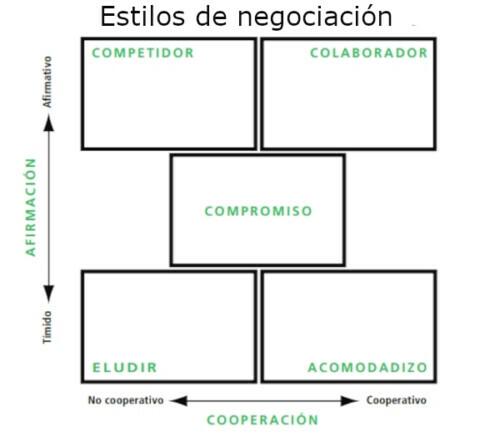In today's business world there are different negotiation style classesthat allow the parties involved to address conflicts and reach an agreement that satisfies them; Of course, one negotiation is not the same as another, and a good negotiator must know how to identify and implement the negotiation style that best suits them to achieve the desired results.

Advertisements
To do this, it is necessary to know all the conditions or contexts of the negotiation process, and have clear what the objective is, as this is a key factor when choosing the style to use.
Let's see which are the most implemented negotiation styles.
Advertisements
In this article you will find:
What are negotiation styles?
The business styles They refer to the different forms and strategies that companies and entrepreneurs can adopt to conduct their commercial operations and relate to their clients, collaborators, and other interested parties.
Well, negotiation is a process in which done or more parties seekreach a mutually satisfactory agreement, and during the process, different individuals may adopt various negotiation styles based on their objectives, their approach to the relationship with the other party, and their willingness to cooperate.
Advertisements
In addition, companies can adopt a negotiation style influenced by various factors such as its corporate culture, the vision of the company's leaders, and the market in which the company operates.
Negotiation style classes
Different authors agree that There are different kinds of negotiation styles, but there are particularly five fundamental styles, based on Thomas Kilmann's model for conflict resolution, which have achieved great popularity, these are:
Advertisements

Competitive negotiation style
With the competitive style negotiation, one party seeks to impose itself on the other, seeking mainly to satisfy its own interests, often at the expense of the other party.
Advertisements
This approach It is characterized by high assertiveness and low cooperation, where the negotiator who uses this style can use aggressive tactics, such as manipulation or ultimatums, to achieve their goals. Although it may result in short-term gains, the competitive approach can damage long-term relationships and create an environment of distrust.
It is a strategy that can be useful in one-time negotiation situations where future relationships are not a primary concern; Since, this style places emphasis on victory, and the measure of success is ultimately how much has been won, regardless of what cost.
Cooperative negotiation style
He collaborative style, unlike the previous one, seeks to find a solution that is mutually beneficial for all parties involved, this style emphasizes both assertiveness and cooperation, promoting open and honest communication, and fostering trust and mutual respect.
By taking a collaborative approach, negotiators are willing to invest time and effort in understanding the needs and concerns of the other party, in order to find creative solutions that maximize benefits for all.
This approach is particularly useful in situations where long-term relationships are important, and where there is the opportunity to create additional value through collaboration and working in equipment. In the end, The objective isreach a solution that leaves all parties satisfied, fostering lasting relationships based on trust and mutual respect.
Accommodative negotiation style
He Accommodative style focuses more on maintaining harmony and positive relationships than on gaining for oneself, individuals who take this approach are willing to make significant concessions to preserve the relationship, even if it means sacrificing their own interests.
This style It is characterized by low assertiveness and high cooperation, often prioritizing the needs and desires of the other party, and although it can help maintain peaceful and cordial relations, the style Accommodating can also lead to unsatisfactory outcomes for the accommodating party, as they may fail to defend their own interests. effective way.
This approach may be appropriate in situations where the relationship is more important than the outcome. specific to the negotiation, or where there is a recognition that the other party has a stronger position strong.
Avoidant negotiation style
With the avoidant style, as its name indicates, involves actively avoid direct confrontation, people who use this style tend to withdraw or postpone the discussion, preferring not to get involved in the conflict.
This approach It is characterized by low assertiveness and low cooperation; Although this style can be useful to avoid unnecessary conflict or to buy time for gathering more information, can also result in the avoidance of important problems and decisions postponed.
At worst, this style can lead to passive outcomes where neither party is truly satisfied, although it may be appropriate in situations where the potential gains do not justify the effort and stress of negotiation, or where time is needed to evaluate the available options.
Compromise negotiation style
He compromise negotiation styleseeks to find an intermediate solution that is acceptable to all parties involved; This approach involves a moderate level of assertiveness and cooperation, seeking common ground through mutual concessions.
While the compromise style can facilitate quick agreements and help maintain relatively cordial relationships, It can also lead to solutions that are not completely satisfactory to either party., since each party has to give in some aspects.
It is a practical approach that can be useful in situations where it is important to reach a solution in a limited time, or where the parties have opposing interests, but equally valid, this style seeks to balance one's own interests with those of others, with the aim of finding a solution that, although not ideal, is acceptable to all.


